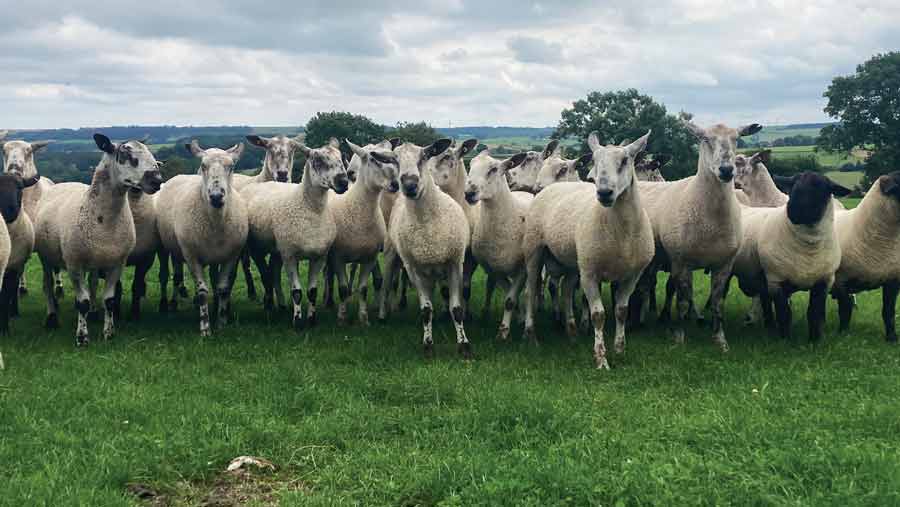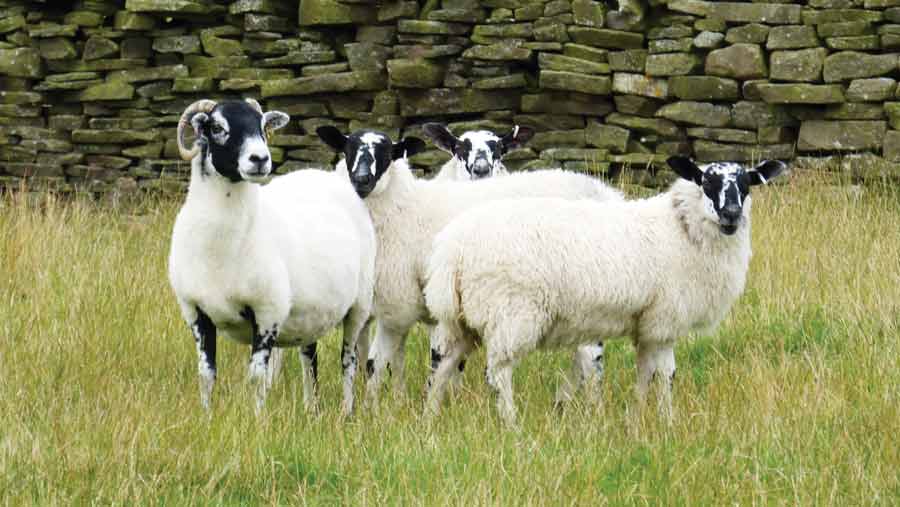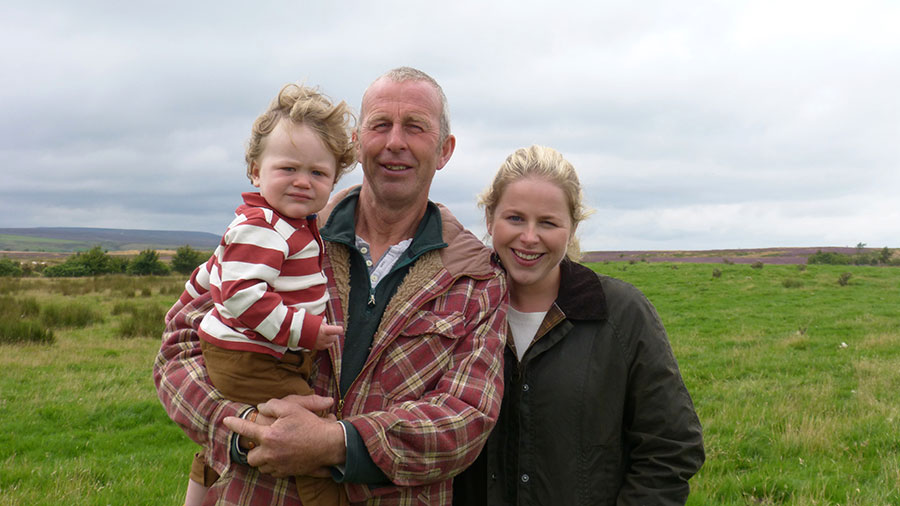Closed policy yields 1.7 lambs reared for Durham flock
 © MAG/Michael Priestley
© MAG/Michael Priestley A string of flock health setbacks has forced a Durham family to rely on its own breeding to maintain high output in its stratified sheep outdoor lambing system.
Several iceberg diseases have plagued the Murrays at Glebe Farm, Tow Law, but weaning 1.7-1.8 lambs a ewe tupped has maintained their interest in North of England Mules.
See also: How maedi visna led to whole flock cull
When ovine pulmonary adenocarcinoma (OPA) and Borders disease were bought in, it had a “demoralising” effect on John Murray, who farms with parents Ashley and Enid and his two daughters, Hannah Spence and Eve. But he believes this is now in the past.
Last year the farm sold more than 1.7 lambs a ewe and has weaned more than 1.7 this summer, which included 40-50 pet lambs, but not the Bluefaced Leicester lambs.
Glebe Farm
- 800 ewes, of which 465 are Swaledale and Blackface-cross
- Farming 250ha
- 90ha rented, rest owned
- All less-favoured or severely disadvantaged land
- 13ha of arable (barley and oats)
- 16ha heather, 28ha rough grazing and 3.2ha of woodland
- 80 suckler cows, including Hanneve Limousins
- 30 pedigree Bluefaced Leicesters
- Selling prime lambs deadweight to ABP
Traditional breeding
The Murrays farm where the Durham Dales meet the Pennines. Land stretches from ploughable land at 213m to heather moor at 324m.
The sheep complement a pedigree Limousin suckler cow enterprise. Last year, amid the dry spell and higher costs, ewes with bad feet were culled, dropping numbers from 850-head to 800.
The family previously bought 140-160 Swaledale gimmer lambs a year from flocks involved in the stratified sheep system.
They bred everything to a Bluefaced Leicester crossing tup, retained about 200 Mules to put to a Suffolk ram and sold a similar number at the Tow Law Mule lamb sale.
But buying in from flocks that historically had no health accreditation eventually led to disease breakdowns.

© MAG/Michael Priestley
Health challenges
The setbacks were as follows:
- 2013: Outbreak of enzootic abortion in the Swaledales
- 2014: Bought 140 Scottish Blackface gimmer lambs at the enzootic abortion-accredited sale at Stirling United Auctions and started cross-breeding to a Swaledale ram. Later that autumn, a second Swaledale ram, bought in as a chaser, tested positive for Border disease
- 2015: Outbreak of caseous lymphadenitis (CLA), thought to be introduced to the flock by shearers
- 2017: Bought in ovine pulmonary adenocarcinoma (OPA) in a Bluefaced Leicester tup. The ram died within weeks. All Swaledale ewes and tup lambs that came into contact with him were culled.
Sheep system at Glebe Farm
- Winter feeding: Ewes are trough-fed for five to six weeks before lambing, which cost £10.45 a head this year (ewe rolls at £393/t).
- Lambing: All outdoors, for two cycles from 1 April, with hoggs a week later. Just 20 lambing pens and 15 adopter pens are inside. Singles lamb away from the farm, so the amount of fostering done is limited.
- Labour: Three family members work at lambing, doing two checks and a midday trough feed.
- Pet lambs: About 40-50 pet lambs a year are reared on a Milk Maid 2000. By contrast, in spring 2018 (Beast from the East), 160 pet lambs needed rearing.
- Post-weaning: Mule gimmers are fed on grass and sold as running lambs. Suffolk-cross prime lambs are drawn up to 46kg (ABP pays up to 22kg deadweight). Some Mule hoggs with lambs at foot are sold. Last year, 59 averaged £129.85 a life at Hexham
- Prolificacy: Rather than focusing on weaning just twins, the breeding policy has been to select from five to seven crop ewes that have raised twins and triplets and lambed easily with no mothering, feet or milking issues. This is starting to pay off. This year, a small field of 33 triplet ewes and hoggs with twins weaned 132 lambs.

John Murray with daughter Hannah © Michael Priestley/MAG
Putting it right
The Murrays have avoided public sales while dealing with Border disease, only selling directly to flocks with known Border issues, but last year returned to Hexham’s Tow Law sale.
“We’ve faced the issue and tried to deal with it,” explains John. “We farm our own Mules, so we see the impact of iceberg diseases first hand.”
The farm has good, conscientious sheep-farming neighbours, mostly walled boundaries, and no shared grazing, leading the Murrays to think buying in stock was the problem.
They have taken the following steps to manage disease:
Closed flock
- Sourcing healthy Swaledale rams from known breeders means replacement females can be bred at home
- Swaledale, Bluefaced Leicester and Suffolk rams are now home-bred
- The Suffolks are based on the oldest Signet-recorded, forage-reared Sandyknowe flock of Malcolm Stewart (now dispersed), which was disease accredited and in a health scheme
- The 2022 and 2023 Bluefaced Leicester lambs have been recorded with Signet to improve maternal traits in the absence of being able to buy in from leading flocks. A big focus is on eight-week weight.
- Swaledale tups have been selected from proven five-to-seven-crop sheep showing strength and good lambs, teeth and udders
- When a share in a ram is bought, to prevent inbreeding, semen from the ram is brought on farm and insemination work done by Castle Vets
- Started shearing their own sheep to minimise disease risk
Test and cull
- Several years of blood testing have been required to control Border disease
- This has isolated persistently infected (PIs) animals for culling
Post-mortems
- Post-mortems by Farm Post Mortems, run by Ben Strugnell, started in 2017, and were upgraded to a post-mortem flock health scheme in 2020
- All fallen stock are checked by Ben. This identified the Bluefaced Leicester ram with OPA
Sires with health status
- A Tefrom ram (three-way cross of Texel, East Friesian and Romney) from Robin Hulme of Easy Rams, Shropshire, has been used in a self-replacing experiment to sire Mules. The ram comes from a flock with a health scheme and data behind it. It has been cheap to keep and lambed easily
- The Murrays are looking at sourcing semen from a high index Signet-record Blackface tup from Hedgeley Farms, Alnwick
- On the rare occasion a ram enters the farm, it is quarantined in a byre until blood tests are done for CLA, Border disease and maedi visna
Scanning performance at Glebe Farm since 2017 |
||
|
Breed and age |
Scanning rate 2023 |
Six-year average |
|
Mule ewes |
211% (2% empty) |
217% |
|
Mule hoggs |
131% (5% empty) |
142.5% |
|
Swaledale ewes |
191% (8% empty) |
199% |
|
Swaledale shearlings |
161% (6% empty) |
175% |
|
Scottish Blackface |
N/A (very few left) |
171% |
|
Notes: Swaledale shearlings were hit by a small toxoplasmosis outbreak following vaccine unavailability and Mule ewes were slightly affected by the dry summer |
||
Control
The flock has been making gains in ewe longevity, milkiness and foot rot, with Swaledale shearlings now expected to raise twins and even triplets, says Hannah.
“We are in control of our own decision making and can take things in the direction we want,” she says. “The hassle of sourcing ram semen is worth it to keep out disease.”
Glebe Farm is not an easy farm, but there are much harder ones, and Swaledales can happily rear twins and triplets there, adds John.
“We hope to keep on breeding for more milk and fertility and breeding out lameness, big teats and poor dentition, resulting in more ewes lasting to seven-crop.”
